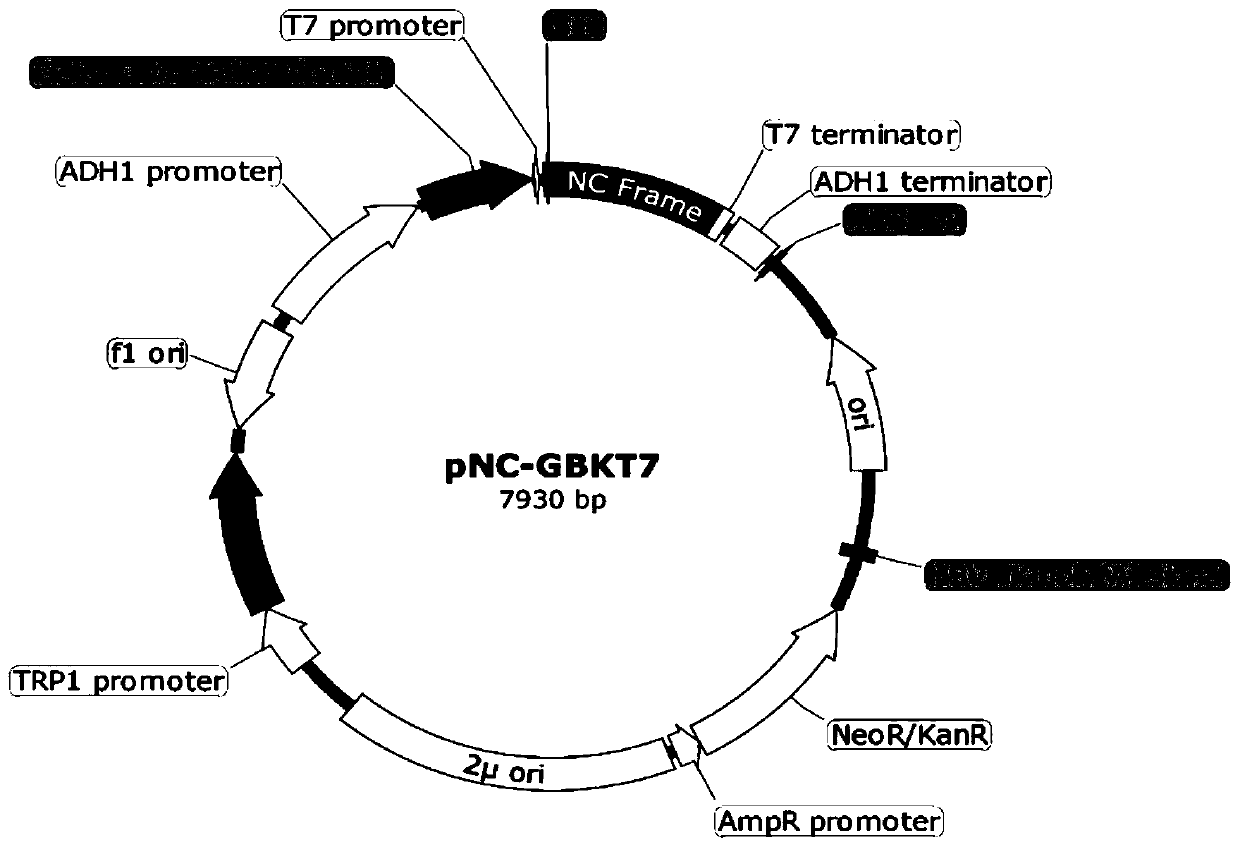Yeast two-hybrid vector, construction method and application thereof in protein interaction
A yeast two-hybrid and construction method technology, applied in the construction method and its application in protein interaction, yeast two-hybrid carrier field, can solve the problems of expensive reagents and cumbersome operation, and achieve the effect of simple operation and high cloning efficiency
- Summary
- Abstract
- Description
- Claims
- Application Information
AI Technical Summary
Problems solved by technology
Method used
Image
Examples
Embodiment 1
[0051] Example 1 Construction of the yeast two-hybrid vector based on Nimble Cloning
[0052] The Nimble Cloning cloning frame provided by the present invention consists of the first linker sequence shown in SEQ ID No.1, SfiI restriction site, ccdB gene, SfiI restriction site and the second linker shown in SEQ ID No.2 Sequences are concatenated sequentially.
[0053] 1.1 Amplification of NC cloning frame
[0054] According to the sequence at the cloning site of the yeast two-hybrid vector pGADT7 and pGBKT7, two pairs of primers (Table 1) were designed, wherein the primer pair NC-ADF and NC-ADR were used to amplify the NC cloning frame AD-NC inserted into pGADT7, The primer pair NC-BDF and NC-BDR was used to amplify the NC cloning cassette BD-NC inserted into pGBKT7. For PCR amplification, the plasmid pNC-UC containing the NC cloning frame was used as a template, and the high-fidelity enzyme PrimeSTAR (Dalian Bao Biology) was used. The reaction conditions were: 94°C for 2 min...
Embodiment 2
[0059] Example 2 Application of yeast two-hybrid vector based on Nimble Cloning in protein interaction research
[0060] The present invention selects the control protein commonly used in the yeast two-hybrid system, murine p53 interacts with SV40 large T-antigen as positive; Human lamin C does not interact with SV40 large T-antigen as negative.
[0061] 2.1 Amplification of the target gene
[0062] According to the nucleic acid sequences of the three genes murine p53, Human lamin C and SV40 large T-antigen used for the positive and negative controls of the yeast two-hybrid experiment, three pairs of primers (Table 1) were designed, among which BD-53F and BD-53R were used for Amplify the murine p53 gene cloned into pNC-GBKT7, BD-LamF and BD-LamR are used to amplify the Human lamin C gene cloned into pNC-GBKT7, AD-TF and AD-TR are used to amplify the cloned pNC-GADT7 SV40 large T-antigen gene. The 3 pairs of primers used the plasmids pGBKT7-53 (pBD-53), pGBKT7-Lam (pBD-Lam) a...
Embodiment 3
[0067] Example 3 Comparison of cloning efficiencies of two cloning methods based on Nimble Cloning yeast two-hybrid vectors
[0068]Nimble Cloning-based yeast two-hybrid vectors pNC-GADT7 and pNC-GBKT7 were used, and the target genes were murine p53, Human lamin C and SV40 large T-antigen. Nimble Cloning and currently widely used Gibson cloning were used to clone the target genes into vectors to compare their cloning efficiencies. The primer designs of the two cloning methods are the same, and they are all the sequences listed in Table 1. The operation of Nimble Cloning is the same as that described in 2.2. The operation of Gibson cloning is as follows: firstly digest the vectors pNC-GADT7 and pNC-GBKT7 with SfiI, the enzyme digestion reaction condition is 50°C for 1 hour, and then recover by agarose gel electrophoresis; the recovered linearized vectors are respectively combined with the target gene The fragments were mixed, added to Gibson Mix (NEB), and reacted at 50°C for...
PUM
 Login to View More
Login to View More Abstract
Description
Claims
Application Information
 Login to View More
Login to View More - R&D
- Intellectual Property
- Life Sciences
- Materials
- Tech Scout
- Unparalleled Data Quality
- Higher Quality Content
- 60% Fewer Hallucinations
Browse by: Latest US Patents, China's latest patents, Technical Efficacy Thesaurus, Application Domain, Technology Topic, Popular Technical Reports.
© 2025 PatSnap. All rights reserved.Legal|Privacy policy|Modern Slavery Act Transparency Statement|Sitemap|About US| Contact US: help@patsnap.com



